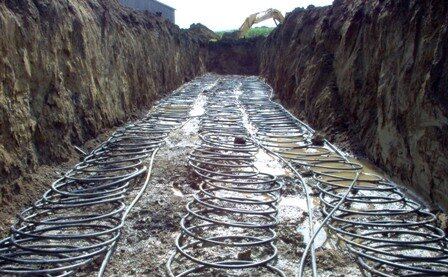Setting up a Geothermal system is one way you can harness clean energy directly under your feet. If you are thinking about heating, ventilation, and air conditioning while off-grid, then you should be considering Geothermal energy.
Geothermal energy uses the constant temperatures from underground to provide cooling and heating to your home. Have you been in a cave where the temperature is warmer than the air above it during the winter and cooler than the air in the summer? That’s how geothermal systems work.
A geothermal (ground-source) heat pump doesn’t create cold; it moves heat. In summer, it pulls heat from your house and dumps it into the ground, which stays roughly 40–70°F a few feet down. In winter, it does the reverse—pulling mild heat from the ground and concentrating it to warm the house. Because the ground temperature is steady, the system avoids the extremes that make ordinary air conditioners and air-source heat pumps work harder.
In this article, you will learn about a simple DIY Geothermal system you can set up all by yourself (depending on where you live) for small structures such as a greenhouse, shed or cabin.
Are you ready?
The depth your pipes need to be will depend on your climate. Environtech Thermal is in Canada and has a very informative website.
Types of Geothermal Systems
Geothermal systems are categorized into two categories - closed-loop system and open-loop system.
Closed Loop system
The closed-loop system has been the dominating choice. In a closed-loop system, there are three types of configuration.
Horizontal - Requires trenches to be deepest, with enough land to stretch out the looping pipes. Plastic (HDPE) piping is laid in trenches 4–6 feet deep. The horizontal system is pretty easy and does well for a DIY project - that's why we went with the horizontal.
Vertical - Requires drilled holes into the earth like a well and are often used in urban areas with little land space. U-bend pipe pairs go down 100–400 feet in small-diameter boreholes spaced ~20 feet apart. Choose this when land is tight or soils are rocky. It offers steady performance but usually higher drilling cost.This is definitely not the kind of system you should map out yourself. When it comes to verticals, you need a professionals.
Pond/Lake - Looping pipes are placed under the surface of a pond. Coils are sunk in around 8 feet below the surface in cold climates to avoid freezing. Lowest trenching/drilling disturbance if you have the right water body on site. Still, you will need a professional to help you out.
Open Loop System
The open-loop system does not need pipes to be looped. This system uses a well or a surface water body as its heat exchanger. Once the water drawn from the well or water body surface has circulated the system, it is then released back into the ground or the water surface body.
Open-loop systems are regulated by the EPA since water is put back into the environment. So I dont recommend them for DIY or homesteaders.
What to Consider Before Setting up a Geothermal System
Before you start digging holes or lining up trenches into the earth, there are things you have to put into consideration. These things include:
The size of your land space - The available land space is what tells you you have to dig out a vertical or horizontal trench and how far they extend to accommodate looping pipes.
Climate of your state or country - Depending on where you live, ground temperatures six feet below the surface average from 45°F (7°C) to 75°F (21°C). Contact your Extension Office or USGS office to get local information.
Soil type - Another variable that could make you dig in further is soil type. Dry soil doesn't do well at transferring heat. Moist soil does better. So if you have dry or sandy soil on the level where you've dug, it still means you will have to dig further until you find a moist or dense clay. Your local USDA office can help you with soil maps for your area.
Know where any electrical, water, or leach lines run from the home. Call your city or county office and have someone come and mark lines for you. This is usually a free service.
Other things that can also be taken into account are the house heating and cooling load, underground utilities, and local building regulations.
A three-ton slinky loop prior to being covered with soil. The three slinky loops are running out horizontally with three straight lines returning the end of the slinky coil to the heat pump. Photo by Mark Johnson
Components for the Geothermal System
Just to make the whole process easy and less costly, it's better off sourcing for simple affordable equipment that could be laying around us.
You can choose to buy your supplies as a kit as well - like this one on Amazon.
For digging up the trench, a spade or shovel might just get the work done. This works fine if you are doing a small project such as a greenhouse.
But for a home, even a small cabin, using a backhoe is a great idea. Many rental equipment companies have excavators.
Looping pipes: a simple plastic pipe would work for a small project like a greenhouse, but since we are more interested in the pipe's efficiency to transfer heat, looking into a High-Density Polyethylene (HDPE) Pipe. Also remember that the earth is going to put pressure on the pipes so quality is important. Quality loops are routinely warrantied for approximately 50 years.
Heat pump unit: A ground-source heat pump (GSHP) can provide space heating and space cooling. Like a refrigerator or air conditioner, these systems use a heat pump to force the transfer of heat from the ground to the building.
In contrast, an air source heat pump draws heat from the colder outside air and thus requires more energy.
The indoor box with compressor, heat exchangers, and controls. Some are water-to-air (using ducts for cooling/heating), others are water-to-water (feeding hydronic coils like with radiant floors).
A 12V brushless water pump is used to power the water circulation through the closed loop system.
A car radiator can also be used as an inexpensive heat exchanger although for heat exchange there are various factors, including its size and compatibility with the fluids you intend to use. These radiators are a type of heat exchanger that are designed to transfer thermal energy from one medium such as hot fluid to another typically air.
Geothermal air conditioning systems still need a power source to power the whole system. Usually, a battery is used to power the car's radiator fan and the water pump, but it wouldn't serve efficiently or for a long period of time without you having to recharge.
So I suggest having the system powered by the sun and at the same time, having the battery recharged for the night. Obviously, the size of your panels and battery need to reflect how much power your system needs.
Read my article Can I run "THIS" on Solar Energy?
Cost of Setting up a Geothermal Air Conditioning System
Yes, I know, not only are geothermal systems labor intensive to build they can be fairly expensive. Costs vary widely by site and loop type (trenching vs. drilling). Recent nationwide consumer estimates put typical installed costs for a “traditional” residence roughly in the $15,000–$40,000+ range, with horizontal loops often on the lower end and deep vertical systems on the higher end.
Obviously a small project will cost less.
Staying Cool in Your Off Grid Cabin
There are many ways to work with nature and stay cool during the summer. I lived off grid in Kentucky 20+ years and never had AC. Strategies such as shutting the windows during the day and opening them at night, planting trees and shrubs at the east and west side of the home for shade, taking a dip in a creek, using smaller solar run fans are effective. Check out my article on ways to stay cool off grid.
Ways to lower costs
Look into sourcing parts as cheaply as possible.
Almost every home has a spade or shovel. Mixed with a little motivation many smaller projects can be hand dug.
A 300 feet geothermal PE looping pipe with 20mm thickness would cost (at the time of writing) $150 or a little more. PEX-B Pipe 3/4 Inch x 300 Feet Coil, Red Tubing for Radiant and Hydronic Heating Systems
Auto parts store or junkyards sometimes carry used radiators
general Setup Process
So before we go on to dig, be sure to have a building permit from your local jurisdiction first (in regions that require you to have one).
Use your spade or hand digger to dig, dig, dig. The ideal trench depth for a horizontal system is usually 4 - 6 feet and spanning up to 400 feet in length for a horizontal looping system
After the trench is completely dug, layout your looping pipes on the ground through to the end of the trench. Note that we are following a closed looping system here. So you have to lay out your pipes in a way to make both the inflow/outflow pipe holes face your home.
Connect the side of the water pump that takes in water to one end of the looping pipe and connect the other side that pumps out water to the top hose of the radiator. The aim is to get water that has gone through the looping pipe to run into the radiator. Connect the lower hose of the radiator which should allow for outflow back into the looping pipe that has been buried underground.
Some would prefer using thermal pipes to make connections between the water pump, the radiator, and back to the looping pipes. But if you don't have any and can afford to make a clean connection, it's absolutely fine. After the connection is done and both the radiator and water pump have been plugged into your solar power source, place the radiator at a height high enough to circulate air in the room.
Advantages of a Geothermal Air Conditioning System
It is renewable energy.
Great way to reduce your carbon footprint.
Low maintenance cost.
It is effective in all regions and climates.
Suitable for most homes and businesses.
It is totally safe and environmentally friendly.
Disadvantages of a Geothermal Air Conditioning System
Lack of land availability can be a drawback.
Important underground work can be destroyed during the digging process.
High upfront setup cost.
The system still has to be powered by an external source.
Guest Author, Ben Danor, (2019) is a Cross Riverian who cares for his environment. He writes on a wide range of genres. In his spare time, he writes lyrics and compose songs. He is also a lover of animals.
Updated 2025 by Ame Vanorio, founder of Fox Run EEC, environmental educator, and author with 25+ years of experience living off grid.






